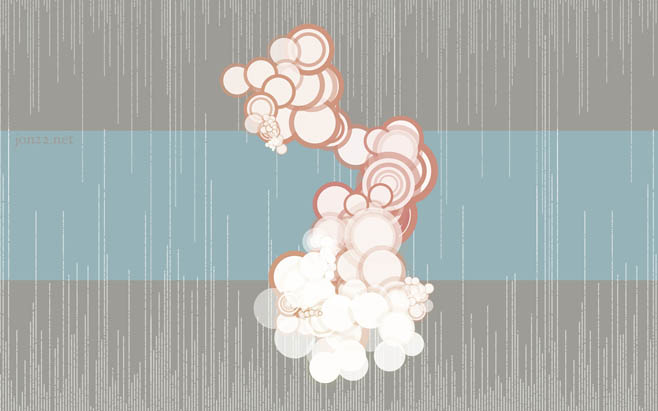posted July 7 2008
a wallpaper and the story of a boy and a turtle
A new wallpaper! Click the image above to download a 1440x900 version. I know that Jon Hicks pretty much has the design market cornered on overlapping circles, but I couldn’t resist.
The explosion of circles and the broken vertical lines were generated using Context Free Art, which I found via the online implementation, which I found via Hans John Gruber. God bless our glorious, golden age of hyperlinks, because creating those circles and dashes in Photoshop or Illustrator by hand would’ve taken me hours. In Context Free Art they took minutes. I suppose I could have gotten clever with dynamic brushes, but it still would’ve been immensely time consuming to get the variations right. In Context Free Art it was just a matter of setting up a few lines of code and pressing Render until I got something I liked. Then off we go to Photoshop to apply what I like to think of as a mid-90s muted color scheme.
As Raskin points out, the whole thing is reminiscent of the ancient Turtle Graphics system, which was designed to teach kids about programming languages. This is harder than it sounds. At their cores, computers are nothing but glorified calculators (more accurately, glorified abacuses). As such, computers are fundamentally boring. Kids are often presented with a thrilling mathscape, and told to program over the course of a week what their pocket calculators could do in seconds. On the other hand, if the teacher gets too ambitious it can feel like you’re being asked to increase the amount of justice in the universe. With a FOR loop.
Enter Turtle Graphics, which for my money has the best programming metaphor ever conceived. Rather than adding numbers, you’re drawing pictures. How are you drawing? Why, there’s a little turtle on the screen who is eager to follow your instructions. Wherever the turtle goes, it draws a line, and from there the possibilities are endless. All the problems of learning about computer programming are solved. Abstraction is reduced to near zero, as you can see the results of your program line by line. It’s not math, it’s art, and at the end of the day you get something that you can print out and magnetize to the fridge.
I must have been in middle school when our Computers teacher introduced us to the turtle. Within ten minutes we had learned how to draw a square. It was just matter of telling the turtle to move forward, turn 90 degrees, and then move forward some more.
forward 50 right 90
forward 50 right 90
forward 50 right 90
forward 50 right 90
Then we learned the shortcut.
repeat 4 [forward 50 right 90]
Since most of us had taken Geometry, it was an easy step up to more complicated shapes.
repeat 6 [forward 50 right 60]
Now I was staring proudly at a blue hexagon. My blue hexagon. For someone with no innate talent for pencils and paper, the geometrically perfect image on the screen was like a revelation. Maybe I could be good at this, I thought.
“Alright, class, five bonus points on Friday’s quiz to the first person who can draw me a circle.”
We all sat there, stumped. To draw a shape, you started with the number of sides. We all got that. Circles, however, do not have sides or angles. They were a smooth mystery. What do circles have? I thought. If I were trying to go all the way around a circle, how would I…
And then came one of those bursts of insight that is so satisfying you’ll remember it fourteen years later.
Degrees. Circles have degrees.
repeat 360 [forward 1 right 1]
And that’s how you get a turtle to draw a large, graceful arc on the screen, with the end meeting the start. I got my five bonus points and called it a day.
Turtle Graphics led to Mac Paint, then Paint, then Visual Reality, and ultimately, inevitably, Photoshop. Context Free Art is to my 2008 what Turtle Graphics was to my 1994. It’s little wonder that I like it so much. I expect to mess around with this thing a lot before I’m through with it.
